The Integrated Design of a Novel Secondary Control and Robust Optimal Energy Management for Photovoltaic-Storage System Considering Generation Uncertainty
Abstract
1. Introduction
2. Design of the Secondary Control Strategy
2.1. Design the Consensus-Based Secondary Controller
2.1.1. The Related Basic Theory
2.1.2. Design of the Secondary Controllers
2.2. Analyze the Influence of the Disturbance on the DG
2.3. Design of the FTSMC-Consistency Controller
2.3.1. Design of the FTSMC
2.3.2. Design of the Event-Triggered Mechanism
2.4. Design the Event-Triggered Secondary Controller
3. Design of the Robust Energy Management Strategy
3.1. Model of PV Power Generation
3.2. Optimization Objective
3.3. Constraints
4. Robust Optimization Framework
4.1. Design of the Robust Optimization Problem
4.2. Particle Swarm Optimization
5. Experimental Results
5.1. Experiment 1: Verify the Control Effect on Secondary Control
5.1.1. Case 1: Verify the Effect of the Secondary Controller without Considering the Line Impedance of BESSs and Loads
5.1.2. Case 2: Verify the Effect of Event-Triggered Mechanism
5.1.3. Case 3: Verify the Effect of the Proposed Secondary Controller Considering the Line Impedance of BESSs and Loads
5.1.4. Case 4: Verify the Effect of the Proposed Secondary Controller when the Load is Changed in Different Time Periods
5.2. Experiment 2: Verify the Effect of the Proposed Robust Optimization Strategy
6. Conclusions
Author Contributions
Funding
Conflicts of Interest
Nomenclature
| Full Name | Abbreviation |
| Photovoltaic | PV |
| Microgrid | MG |
| Finite time sliding mode controller | FTSMC |
| Battery energy storage system | BESS |
| Particle swarm optimization | PSO |
| Distributed generator | DG |
Appendix A. The Related Simulink Model
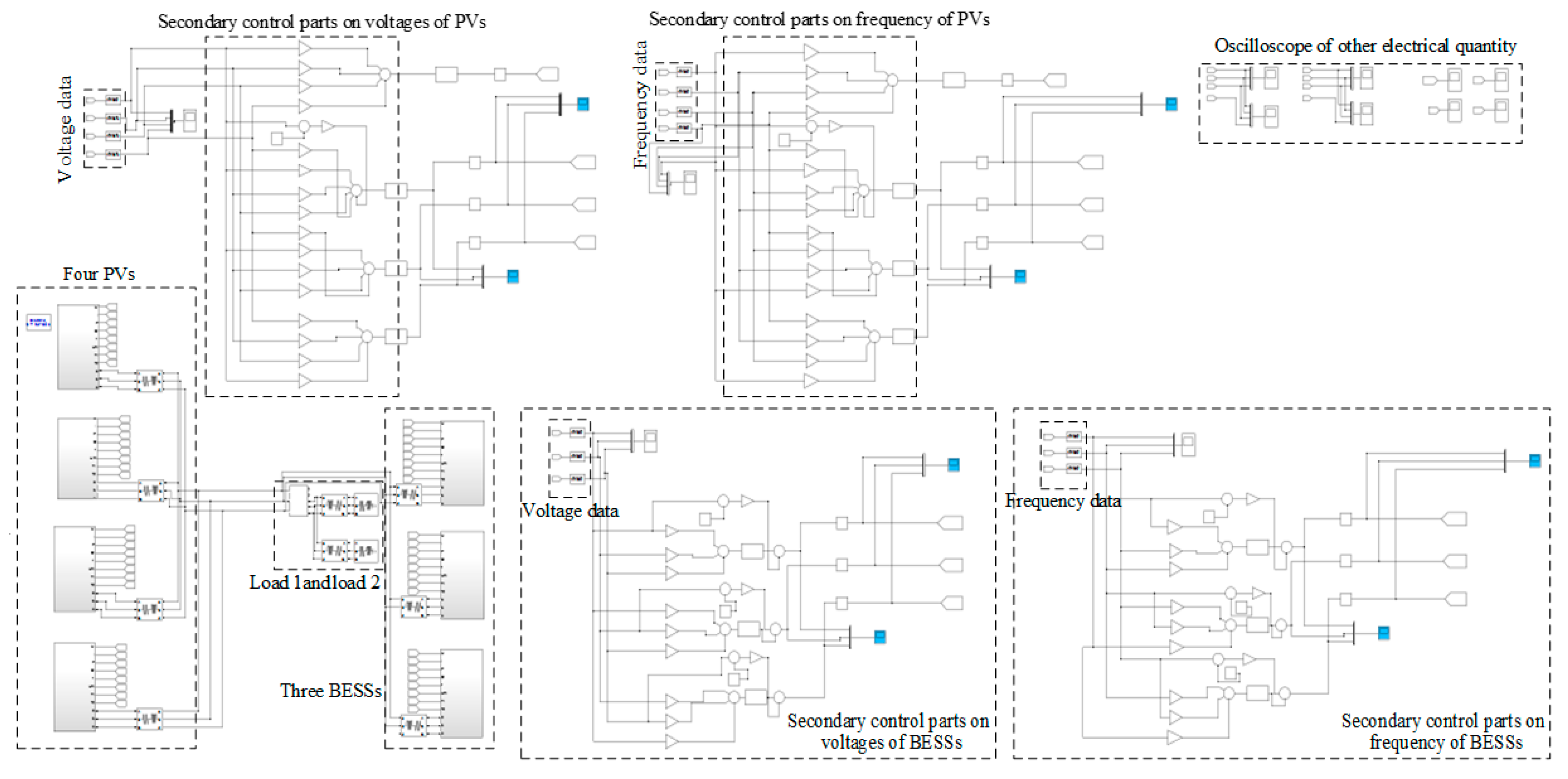
References
- Harmon, E.J.; Ozgur, U.; Cintuglu, M.H.; de Azevedo, R.; Akkaya, K.; Mohammed, O.A. The Internet of Microgrids: A Cloud Based Framework for Wide-Area Networked Microgrids. IEEE Trans. Ind. Inform. 2018, 14, 1262–1274. [Google Scholar] [CrossRef]
- Collier, S.E. The Emerging Enernet: Convergence of the Smart Grid with the Internet of Things. IEEE Ind. Appl. Mag. 2017, 23, 12–16. [Google Scholar] [CrossRef]
- Bai, X.; Qiao, W. Robust optimization for bidirectional dispatch coordination of large-scale V2G. IEEE Trans. Smart Grid 2015, 6, 1944–1954. [Google Scholar] [CrossRef]
- Anand, S.; Fernandes, B.G.; Guerrero, J.M. Distributed control to ensure proportional load sharing and improve voltage regulation in low-voltage dc microgrids. IEEE Trans. Power Electron. 2013, 28, 1900–1913. [Google Scholar] [CrossRef]
- Nasirian, V.; Davoudi, A.; Lewis, F.L.; Guerrero, J.M. Distributed adaptive droop control for dc distribution systems. IEEE Trans. Energy Convers. 2014, 29, 944–956. [Google Scholar] [CrossRef]
- Savaghebi, M.; Jalilian, A.; Vásquez, J.C.; Guerrero, J.M. Secondary control for voltage quality enhancement in microgrids. IEEE Trans. Smart Grid 2012, 3, 1893–1902. [Google Scholar] [CrossRef]
- Lu, X.; Guerrero, J.M.; Sun, K.; Vasquez, J.C. An improved droop control method for dc microgrids based on low bandwidth communication with dc bus voltage restoration and enhanced current sharing accuracy. IEEE Trans. Power Electron. 2014, 29, 1800–1812. [Google Scholar] [CrossRef]
- Tahir, M.; Mazumder, S.K. Self-Triggered Communication Enabled Control of Distributed Generation in Microgrids. IEEE Trans. Ind. Inform. 2015, 11, 441–449. [Google Scholar] [CrossRef]
- Zhou, J.; Zhang, H.; Sun, Q.; Ma, D.; Huang, B. Event-Based Distributed Active Power Sharing Control for Interconnected AC and DC Microgrids. IEEE Trans. Smart Grid 2018, 9, 6815–6828. [Google Scholar] [CrossRef]
- Zhao, L.; Zeng, B. Robust unit commitment problem with demand response and wind energy. In Proceedings of the 2012 IEEE Power and Energy Society General Meeting, San Diego, CA, USA, 22–26 July 2012; pp. 1–8. [Google Scholar]
- Valencia, F.; Collado, F.; Saez, D.; Marín, L.G. Robust Energy Management System for a Microgrid Based on a Fuzzy Prediction Interval Model. IEEE Trans. Smart Grid 2016, 7, 1486–1494. [Google Scholar] [CrossRef]
- Hussain, A.; Bui, V.H.; Kim, H.M. Robust Optimal Operation of AC/DC Hybrid Microgrids Under Market Price Uncertainties. IEEE Access 2017, 6, 2654–2667. [Google Scholar] [CrossRef]
- Nojavan, S.; Mohammadi-Ivatloo, B.; Zare, K. Optimal bidding strategy of electricity retailers using robust optimisation approach considering time-of-use rate demand response programs under market price uncertainties. IET-Gener. Transm. Distrib. 2015, 9, 328–338. [Google Scholar] [CrossRef]
- Mazidi, M.; Monsef, H.; Siano, P. Robust day-ahead scheduling of smart distribution networks considering demand response programs. Appl. Energy 2016, 178, 929–942. [Google Scholar] [CrossRef]
- Zhang, Y.; Gatsis, N.; Giannakis, G.B. Robust energy management for microgrids with high-penetration renewables. IEEE Trans. Sustain. Energy 2013, 4, 944–953. [Google Scholar] [CrossRef]
- Xiang, Y.; Liu, J.; Liu, Y. Robust energy management of microgrid with uncertain renewable generation and load. IEEE Trans. Smart Grid 2016, 7, 1034–1043. [Google Scholar] [CrossRef]
- Hussain, A.; Bui, V.H.; Kim, H.M. Robust optimization-based scheduling of multi-microgrids considering uncertainties. Energies 2016, 9, 278. [Google Scholar] [CrossRef]
- Lei, H.; Huang, S.; Liu, Y.; Zhang, T. Robust Optimization for Microgrid Defense Resource Planning and Allocation Against Multi-Period Attacks. IEEE Trans. Smart Grid 2019, 10, 5841–5850. [Google Scholar] [CrossRef]
- Yuan, W.; Wang, J.; Qiu, F.; Chen, C.; Kang, C.; Zeng, B. Robust optimization-based resilient distribution network planning against natural disasters. IEEE Trans. Smart Grid 2016, 7, 2817–2826. [Google Scholar] [CrossRef]
- Alabdulwahab, A.; Abusorrah, A.; Zhang, X.; Shahidehpour, M. Coordination of interdependent natural gas and electricity infrastructures for firming the variability of wind energy in stochastic day-ahead scheduling. IEEE Trans.Sustain. 2017, 6, 606–615. [Google Scholar] [CrossRef]
- Erdener, B.C.; Pambour, K.A.; Lavin, R.B.; Dengiz, B. An integrated simulation model for analysing electricity and gas systems. Int. J. Electr. Power Energy Syst. 2014, 61, 410–420. [Google Scholar] [CrossRef]
- Zhang, H.; Yue, D.; Xie, X. Robust Optimization for Dynamic Economic Dispatch Under Wind Power Uncertainty with Different Levels of Uncertainty Budget. IEEE Access 2016, 4, 7633–7644. [Google Scholar] [CrossRef]
- Zhang, B.; Dou, C.X.; Yue, D.; Zhang, Z.; Zhang, T. A Packet loss-dependent Event-triggered Cyber-Physical Cooperative Control Strategy for Islanded Microgrid. IEEE Trans. Cybern. 2019. [Google Scholar] [CrossRef] [PubMed]
- Fan, B.; Guo, S.L.; Peng, J.K.; Yang, Q.; Liu, W.; Liu, L. A Consensus-Based Algorithm for Power Sharing and Voltage Regulation in DC Microgrids. IEEE Trans. Ind. Inform. 2019. [Google Scholar] [CrossRef]
- Zhang, B.; Dou, C.X.; Yue, D.; Zhang, Z.Q. Response Hierarchical Control Strategy of Communication Data Disturbance in Micro-grid under The Concept of Cyber Physical System. IET-Gener. Transm. Distrib. 2018, 12, 5867–5878. [Google Scholar] [CrossRef]

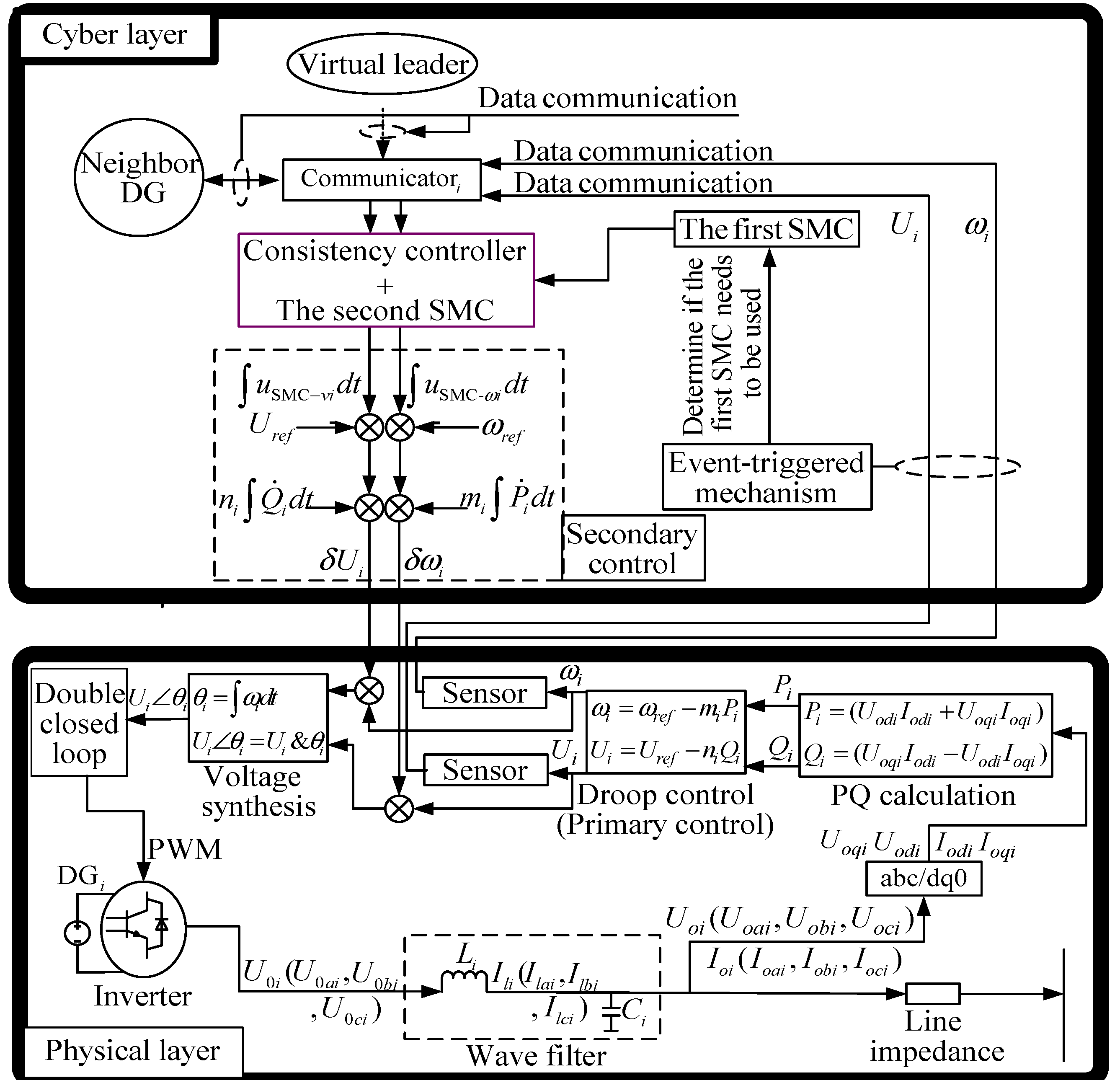
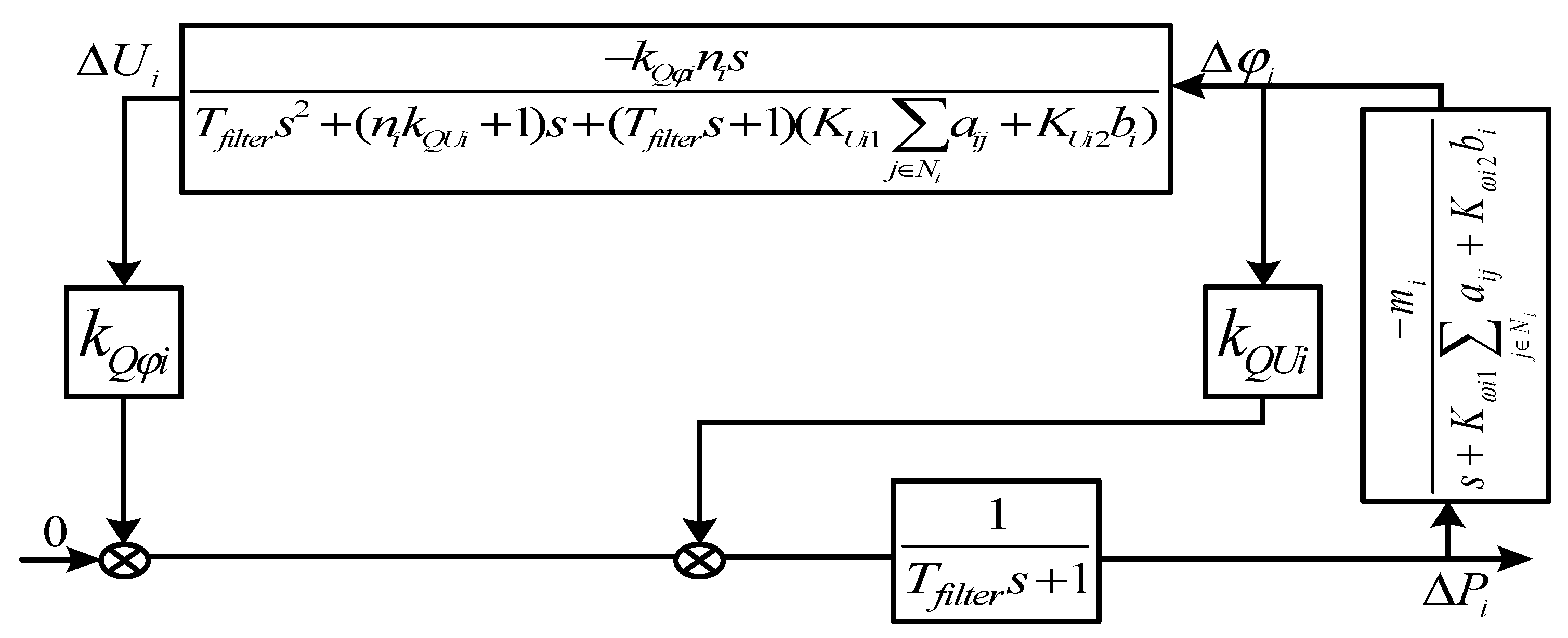
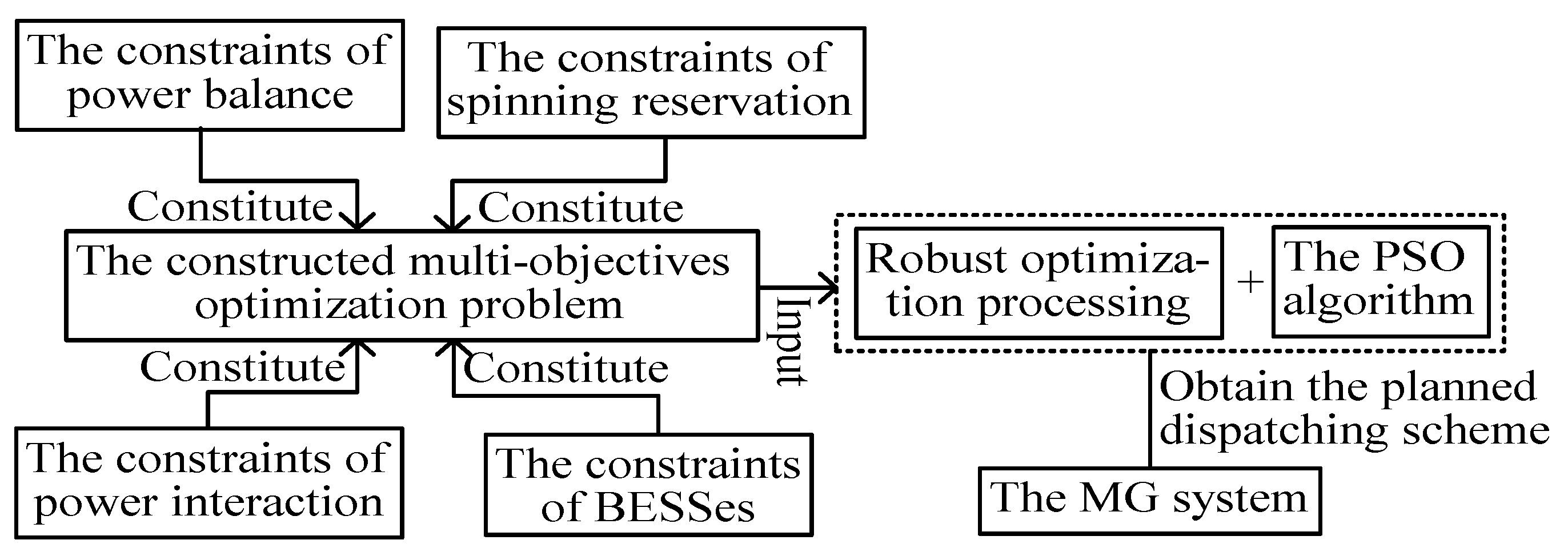
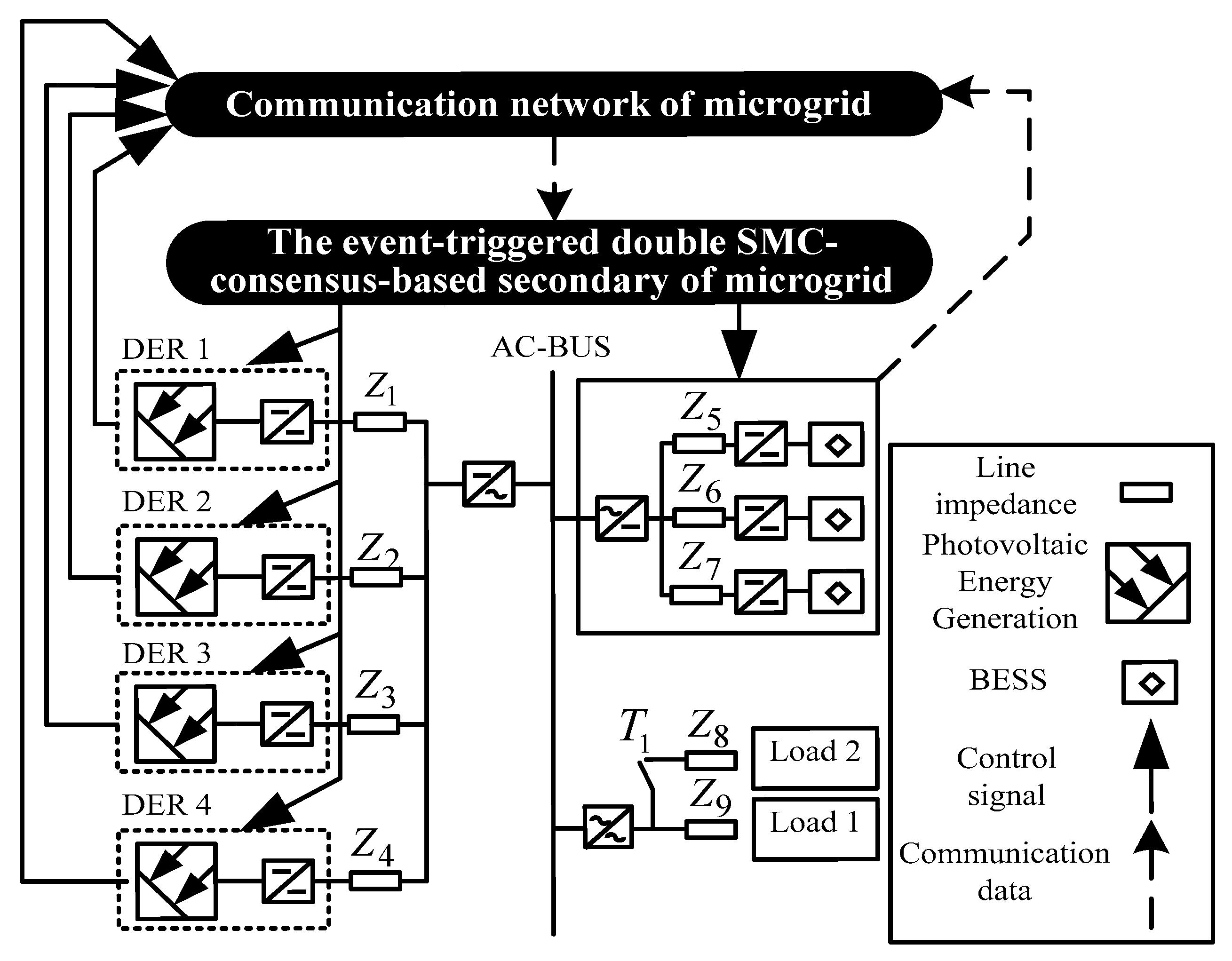
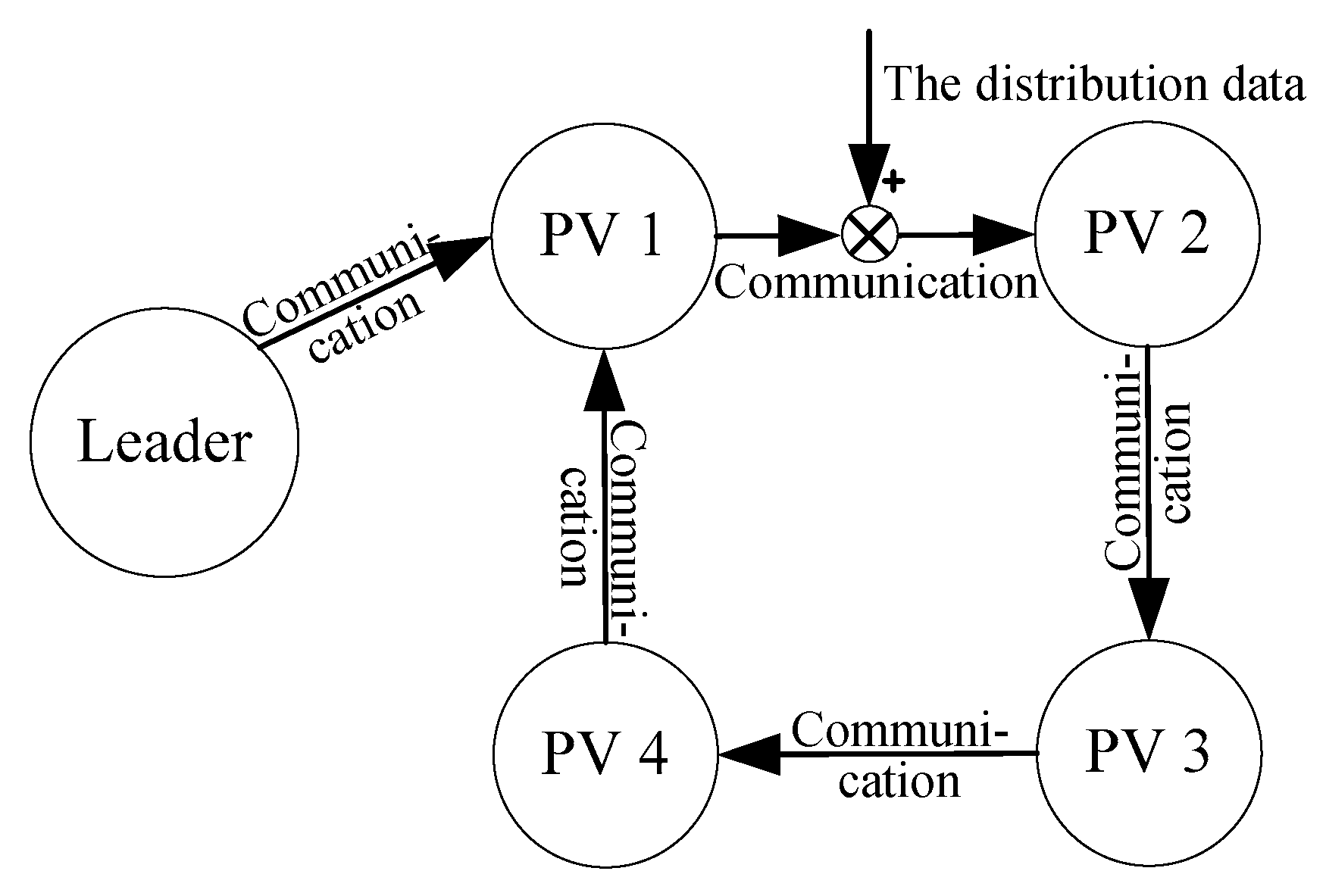

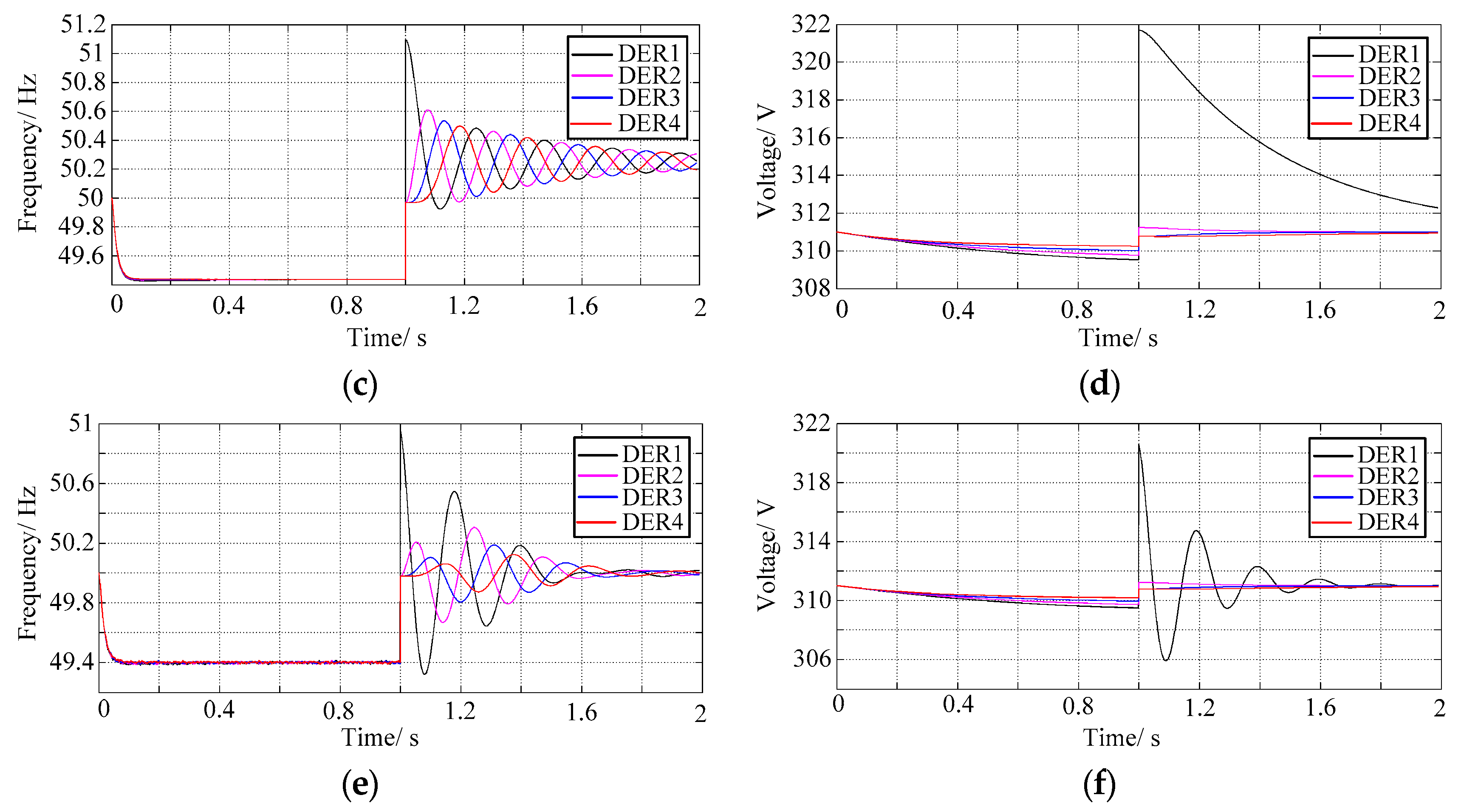


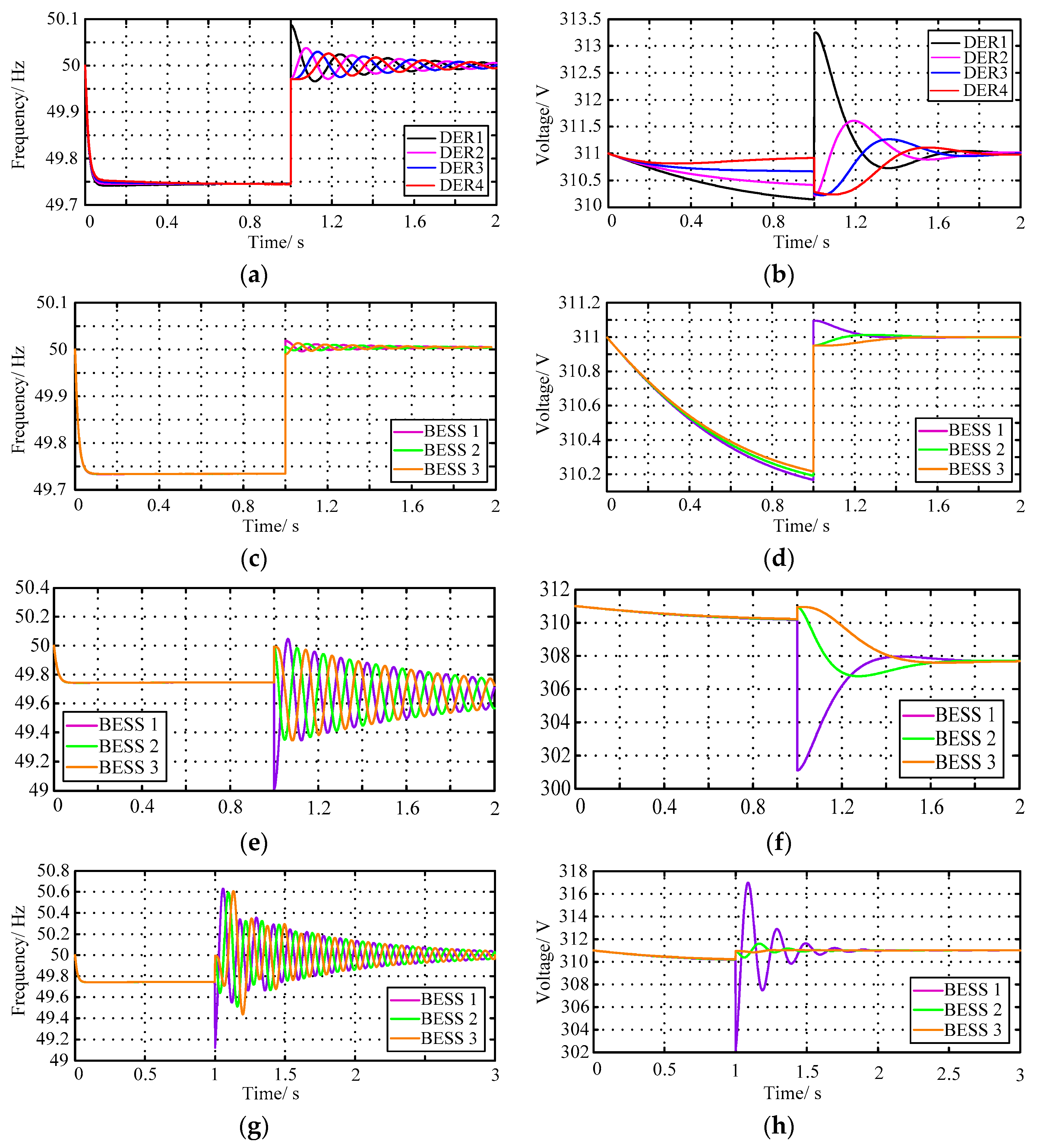
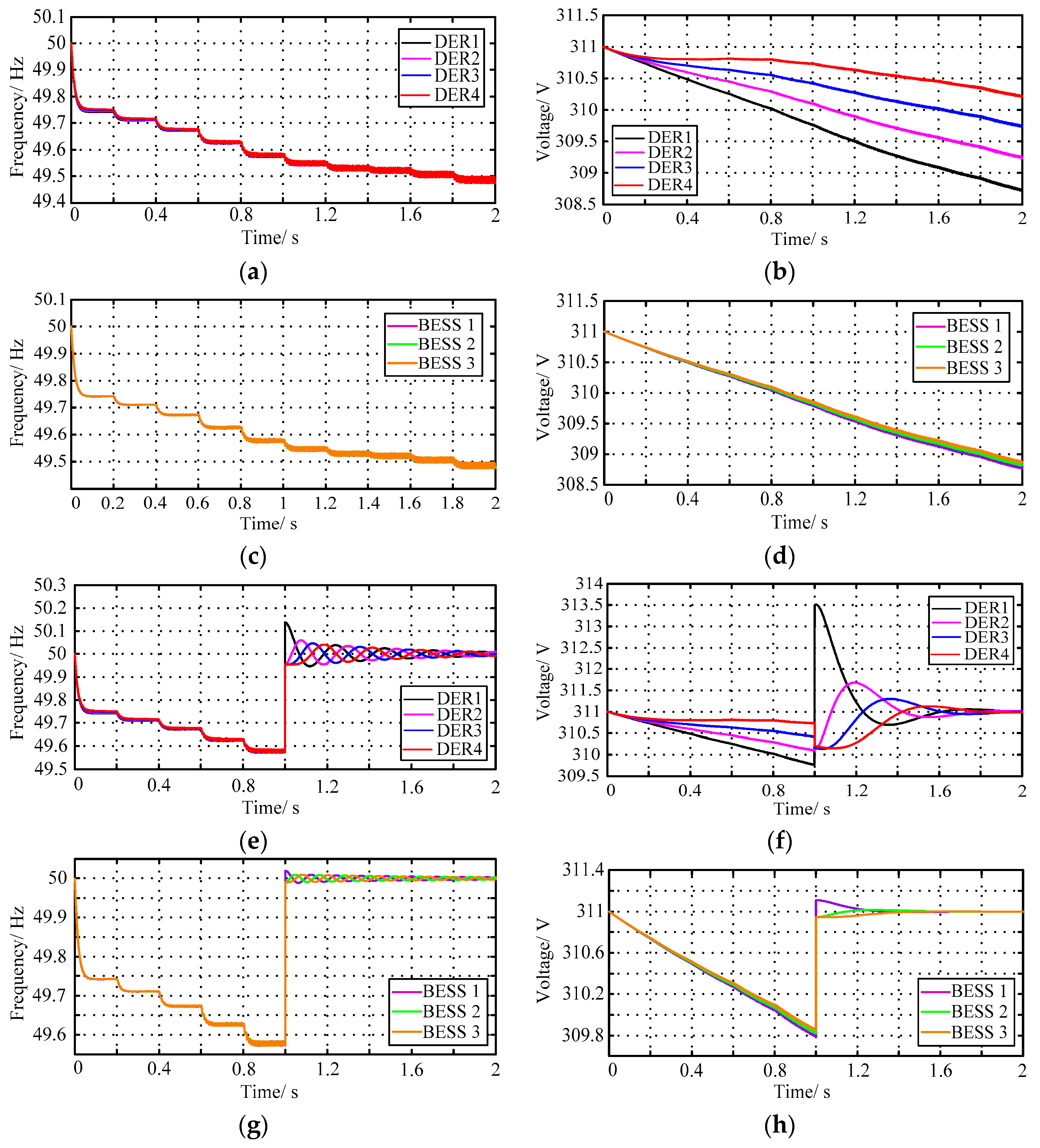
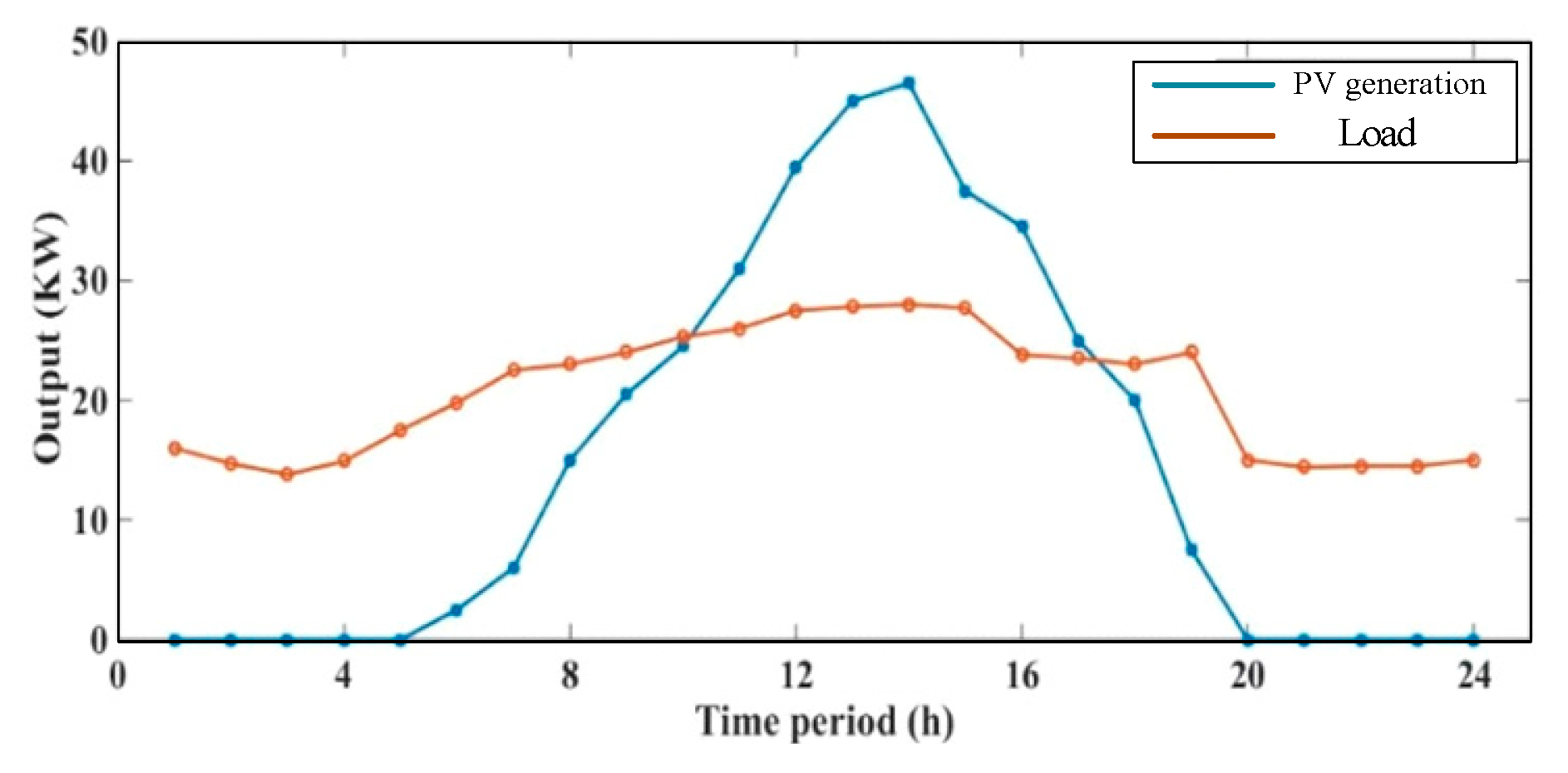


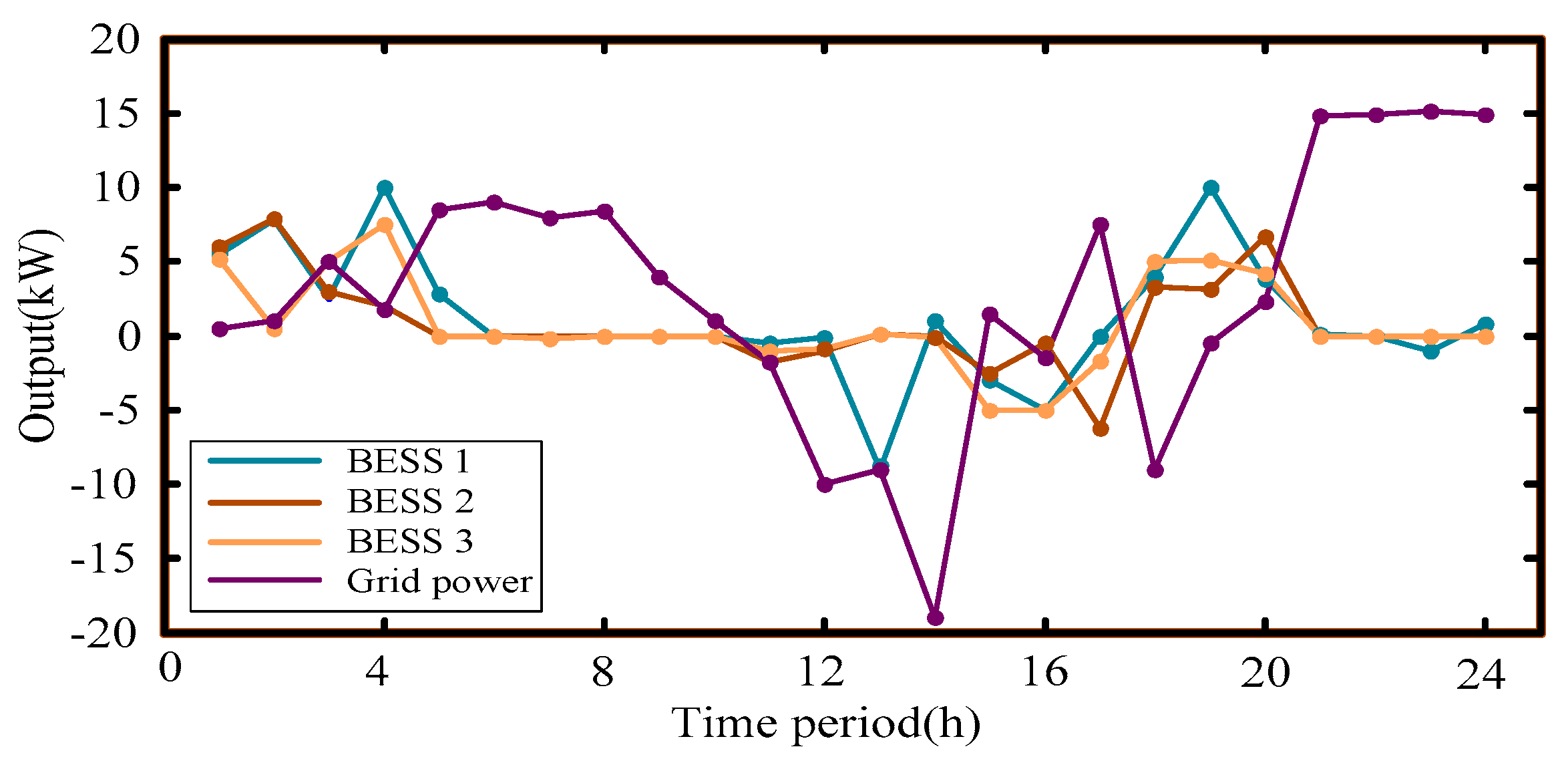
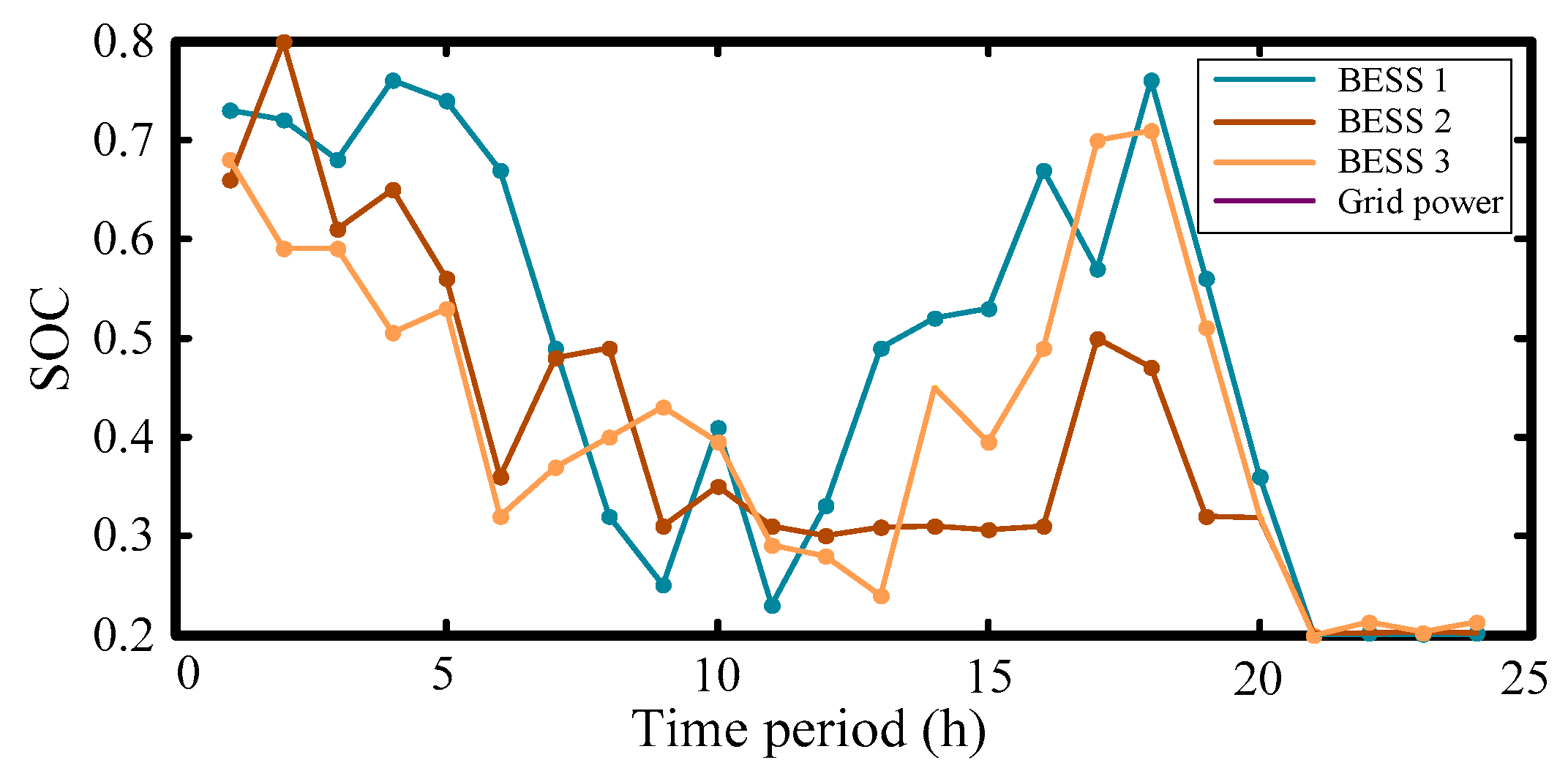

| Parameters | Values |
|---|---|
| The maximum voltage of DGs | 700 V |
| The working frequency of MG | 50 Hz |
| Line impedance (Inductive impedance) | |
| The voltage reference | 311 V |
| The frequency reference | 50 Hz |
| The parameters of Bus | 311 V, 50 Hz |
| Load 1 (inductive load) | |
| Load 2 (inductive load) | |
| The droop coefficients | , |
| The conditions of event-trigger | The trigger value of frequency: 5 Hz The trigger value of voltage: 30 V |
| The communication topology of PVs | |
| The communication topology of BESSs | |
| For PVs: The gains in the consistency controllers | |
| The parameters of virtual leader | 311 V, 50 Hz |
| Trigger conditions (i.e., the maximum disturbance allowed by the MG system) | 5 HZ, 30 V |
| PV 1~PV 4 | Maximum voltage: 700 V; Working frequency: 50 Hz; Maximum power: 50 kW |
| BESS 1~BESS 3 | Maximum voltage: 700 V; Working frequency: 50 Hz; Maximum power: 50 kW |
| The Control Type | The Related Communication Data | The Related Control Signal |
|---|---|---|
| The secondary control of the output voltage of the inverter corresponding to PVs | Voltage data of each controlled PV output by droop control | Voltage feedback generated by voltage consistency controller |
| The secondary control of the output frequency of the inverter corresponding to PVs | Frequency data of each controlled PV output by droop control | Frequency feedback generated by voltage consistency controller |
| The secondary control of the output voltage of the inverter corresponding to BESSs | Voltage data of each controlled BESS output by droop control | Voltage feedback generated by voltage consistency controller |
| The secondary control of the output frequency of the inverter corresponding to BESSs | Frequency data of each controlled BESS output by droop control | Frequency feedback generated by voltage consistency controller |
| Situations | 0~1 s | 1~2 s |
|---|---|---|
| 1 | The system is in normal operation and only depends on the droop control to adjust the output voltages and frequency of PVs. | The system is in normal operation, and secondary control is added to the system at t = 1s. |
| 2 | The system is in normal operation and only depends on the droop control to adjust the output voltages and frequency of PVs. | At t = 1s, the secondary control is added to the system. Meanwhile, the step signals (i.e., the disturbance data) with amplitudes of 1 and 10 are added to the output frequency and voltage data of the PV 1, respectively. |
| 3 | The system is in normal operation and only depends on the droop control to adjust the output voltages and frequency of PVs. | At t = 1s, the secondary control is added to the system. Meanwhile, the step signals (i.e., the disturbance data) with amplitudes of 1 and 10 are added to the output frequency and voltage data of the PV 1, respectively. In addition, we also add the SMC to verify its suppression effect on disturbances. |
| Situation | 0~1 s | 1~2 s | 2~3 s |
|---|---|---|---|
| 1 | The system is in normal operation and only depends on the droop control to adjust the output voltages and frequency of PVs. | At t = 2 s, the secondary control is added to the system. Meanwhile, the step signals (i.e., the disturbance data) with amplitudes of 1 and 10 are added to the output frequency and voltage data of the PV 1, respectively. | At t = 3 s, the secondary control is added to the system. Meanwhile, the step signals (i.e., the disturbance data) with amplitudes of 5 and 30 are added to the output frequency and voltage data of the PV 1, respectively. |
| 2 | The system is in normal operation and only depends on the droop control to adjust the output voltages and frequency of PVs. | At t = 2 s, the secondary control is added to the system. Meanwhile, the step signals (i.e., the disturbance data) with amplitudes of 5 and 30 are added to the output frequency and voltage data of the PV 1, respectively. | At t = 3 s, the secondary control is added to the system. Meanwhile, the step signals (i.e., the disturbance data) with amplitudes of 1 and 10 are added to the output frequency and voltage data of the PV 1, respectively. |
| Impedance of the line corresponding to BESSs | |
| Impedance of the line corresponding to Loads | |
| For BESSs: The gains in the consistency controller |
| Situations | 0~1 s | 1~2 s |
|---|---|---|
| 1 | The system is in normal operation and only depends on the droop control to adjust the output voltages and frequency of BESSs. | The system is in normal operation, and secondary control is added to the system at t = 1s. |
| 2 | The system is in normal operation and only depends on the droop control to adjust the output voltages and frequency of BESSs. | At t = 1s, the secondary control is added to the system. Meanwhile, the step signals (i.e., the disturbance data) with amplitudes of 1 and 10 are added to the output frequency and voltage data of the BESS 1, respectively. |
| 3 | The system is in normal operation and only depends on the droop control to adjust the output voltages and frequency of BESSs. | At t = 1 s, the secondary control is added to the system. Meanwhile, the step signals (i.e., the disturbance data) with amplitudes of 1 and 10 are added to the output frequency and voltage data of the BESS 1, respectively. In addition, we also add the SMC to verify its suppression effect on disturbances. |
| Time Period | 0~0.2 s | 0.2~0.4 s | 0.4~0.6 s | 0.6s~0.8 s | 0.8s~1 s | 1s~1.2 s | 1.2s~1.4 s | 1.4s~1.6 s | 1.6s~1.8 s |
|---|---|---|---|---|---|---|---|---|---|
| The changes of Load 2 | The load 2 is disconnected and not connected to the MG | 30 kW/3 kVar | 90 kW/9 kVar | 180 kW/18 kVar | 300 kW/30 kVar | 390 kW/39 kVar | 450 kW/45 kVar | 480 kW/48 kVar | 570 kW/57 kVar |
| BESS | Current Capacity/kWh | Rated Capacity/kWh | Maximum Use Capacity/kWh | Minimum Use Capacity/kWh | Maximum Charging Power/kW | Maximum Discharging Power/kW | Cost of Charging and Discharging/($/kW) |
|---|---|---|---|---|---|---|---|
| BESS 1 | 37 | 50 | 40 | 10 | 10 | 10 | 0.1825 |
| BESS 2 | 25 | 37.5 | 30 | 7.5 | 7.5 | 7.5 | 0.2375 |
| BESS 3 | 17 | 25 | 20 | 5 | 5 | 5 | 0.2605 |
| Situation | The Related Experiment Process |
|---|---|
| 1 | In this experiment, the predicted output power of PV is used as the actual PV output without PV fluctuations |
| 2 | In this experiment, the actual PV output with PV fluctuations is considered. |
© 2020 by the authors. Licensee MDPI, Basel, Switzerland. This article is an open access article distributed under the terms and conditions of the Creative Commons Attribution (CC BY) license (http://creativecommons.org/licenses/by/4.0/).
Share and Cite
Xu, S.; Sun, H.; Zhao, B.; Yi, J.; Hayat, T.; Alsaedi, A.; Dou, C.; Zhang, B. The Integrated Design of a Novel Secondary Control and Robust Optimal Energy Management for Photovoltaic-Storage System Considering Generation Uncertainty. Electronics 2020, 9, 69. https://doi.org/10.3390/electronics9010069
Xu S, Sun H, Zhao B, Yi J, Hayat T, Alsaedi A, Dou C, Zhang B. The Integrated Design of a Novel Secondary Control and Robust Optimal Energy Management for Photovoltaic-Storage System Considering Generation Uncertainty. Electronics. 2020; 9(1):69. https://doi.org/10.3390/electronics9010069
Chicago/Turabian StyleXu, Shiyun, Huadong Sun, Bing Zhao, Jun Yi, Tasawar Hayat, Ahmed Alsaedi, Chunxia Dou, and Bo Zhang. 2020. "The Integrated Design of a Novel Secondary Control and Robust Optimal Energy Management for Photovoltaic-Storage System Considering Generation Uncertainty" Electronics 9, no. 1: 69. https://doi.org/10.3390/electronics9010069
APA StyleXu, S., Sun, H., Zhao, B., Yi, J., Hayat, T., Alsaedi, A., Dou, C., & Zhang, B. (2020). The Integrated Design of a Novel Secondary Control and Robust Optimal Energy Management for Photovoltaic-Storage System Considering Generation Uncertainty. Electronics, 9(1), 69. https://doi.org/10.3390/electronics9010069




